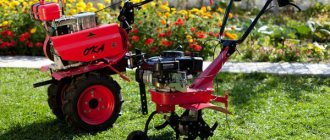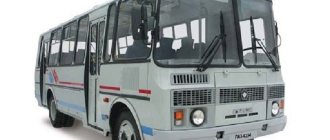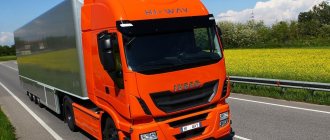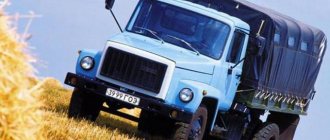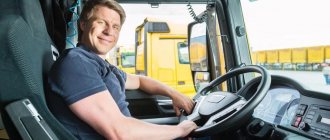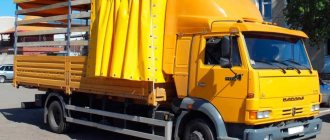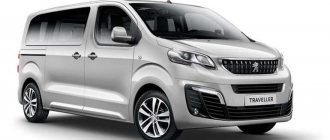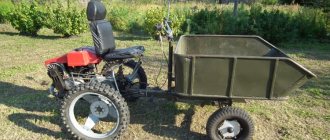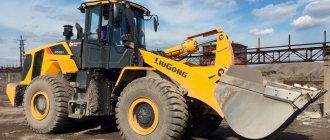Reading time: 6 minutes(s)
The Russian truck market offers equipment of domestic and foreign production. Buyers can determine which tractor is best for Russia based on reviews from vehicle owners or service center employees. It is also important to consider the load capacity and operating conditions of the trucks.
Truck tractor brands
Tractors of various types are designed for towing trailers. Having a low dead weight, the tractor is capable of moving a large volume of cargo. Truck tractors coupled with semi-trailers are more maneuverable and versatile.
So, what technical characteristics can truck tractors boast and how do they differ from each other?
Such brands of tractors as Italian Iveco, French Renault, Swedish Volvo and Scania, Dutch DAF, German MAN, American Freightliner, Belarusian MAZ and domestic KamAZ, Tonar, KrAZ, Ural and others are popular on the Russian market. Over the many years of existence, each brand has managed to recommend its products and find its consumer.
Tractors come in American and European types. Their technical characteristics are approximately the same, the only difference is in the design of the cabin. Americans install the engine in front of the cabin made of chemical fibers and plastic, while European manufacturers make the cabin without a hood, the engine is located under the driver. Each model has its own advantages, for example, European cabs are more complex in design and are made of steel, but their design allows the length of the truck to be reduced. This is a very important characteristic because in many countries there is a limit on the length of vehicles. Regardless of the body design, all types of truck tractors have two or three axles. Three-axle tractors are more powerful and are used where heavy transportation is required.
Modern three-axle truck tractors are available with different wheel designs:
- 6x2. They are chosen because they can carry large loads while maintaining a simple design. They cost 10-20% more than two-axle tractors. The reduced load on the rear wheels determines the use of the equipment only on good roads.
- 6x4 and 6x6. Truck tractors with this wheel design can be used both on highways and off-road. They are equipped with either parallel (one cardan shaft) or serial drive (two cardan shafts). The second drive is more common.
- 8x2, 8x4. This wheel arrangement is found only on very powerful truck tractors designed for towing super-heavy loads.
Also, types of tractors differ in power. Standard tractors have engines ranging from two hundred to four hundred and forty horsepower; the transmission can be either manual or automatic. But, as in any industry, there are giants and record holders, among truck tractors you can find models with an engine of 700-750 horsepower (for example, tractors of the Volvo, Scania brands). The higher the power, the heavier the tractor will be, since the loads expected are completely different than for a lightweight tractor. Some brands of lightweight tractors are not equipped with sleeping accommodations for drivers, since they are rarely used for long-distance transport.
Truck tractors have disc or drum brakes. The suspension is pneumatic or spring; there are models with a combined suspension. Also, tractors can have high, normal, medium and low chassis height and, accordingly, landing height. Today, the engines of the most common brands of truck tractors comply with eco-standards (Euro-3, -4, -5, -6), it all depends only on the desires and financial capabilities of the owners. In Russia, at the moment, the environmental friendliness of the engine does not yet affect road fees and the tax base, but it does affect the first registration in the Russian Federation and customs clearance of imported trucks.
In addition to truck tractors, there are also ballast tractors. They are used to move very heavy loads, such as aircraft and other aircraft, military and commercial equipment. Ballast tractors differ from truck tractors not only in their scope of use, but also in the method of securing the load. Due to their narrow focus, ballast tractors are not very popular.
Rating of tractors for Russian roads
The rating of the most reliable tractors adapted for driving on Russian roads includes:
- German Mercedes-Benz Actros 3;
- South Korean Hyundai HD 120;
- French Renault Premium;
- Japanese Mitsubishi Fuso Super Great;
- German MAN TGX;
- Italian Iveco Stralis;
- Swedish Scania R730 V8 and Volvo FH16;
- Russian KamAZ 5490.
Mercedes-Benz Actros 3
The third generation of Actros tractors includes vehicles with one or two rear drive axles. Long-haul trucks are designed to operate as part of road trains with a total weight of up to 250 tons.
All-metal cabs are available in 11 versions, with a minimum distance between floor and roof of 2,130 mm. The cabs are equipped with adjustable and sprung seats for the driver and passenger.
The machines are equipped with economical diesel engines with electronic fuel control and adjustable turbochargers (a total of 16 models are offered). Compressed air passes through the intercooler, which reduces the gas temperature at the inlet to the cylinders. Maximum power reaches 620 hp; Power Shift 3 automatic transmission is used to transmit torque.
Hyundai HD 120
Trucks of the Hyundai HD 120 series belong to the category of medium-duty vehicles with a gross weight of up to 11.9 tons. The vehicle is equipped with a 250-horsepower in-line diesel engine that meets the Euro 5 emission standard. A manual 6-speed gearbox is used to transmit power. The manufacturer offers several modifications that differ in wheelbase (4,260 and 4,895 mm) and load capacity (7,490 and 7,770 kg, respectively). On separate orders, a chassis with a base of 5,695 mm is supplied.
The chassis can be used to install an onboard platform, an insulated van, or a tank for transporting food and technological liquids. There are modifications with a hydraulic manipulator powered by a built-in pumping station.
In the cabin, designed for the driver and passenger, air conditioning is installed upon request. To increase safety, the VDC stability control system is used.
Renault Premium
The Renault Premium series of reliable and comfortable truck tractors includes the Lander, Route and Distribution modifications. All-metal cabins are equipped with a berth; an original door hinge system is used, which swing open to an angle of 90°.
The trucks are equipped with in-line 6-cylinder supercharged diesel engines, developing power up to 440 hp. The fuel supply system is equipped with an electronic regulator that allows you to reduce diesel fuel consumption (the average consumption of a loaded road train does not exceed 35 liters per 100 km).
The tractors use 16-speed manual transmissions; some modifications have an automatic transmission. The front suspension design retains leaf springs with hydraulic shock absorbers, and the rear axle is mounted on pneumatic cylinders. Disc-type brakes have an anti-lock braking system that reduces braking distance.
Mitsubishi Fuso Super Great
Used tractors and dump trucks based on the Mitsubishi Fuso Super Great chassis are supplied to Russia from Japan. The cars are distinguished by right-hand drive; there are cabins without a sleeping compartment, designed to carry a driver and a person accompanying the cargo. The chassis is equipped with a standard rear bogie with two drive axles, but there are modifications with one drive axle and two steering axles. To install isothermal vans, a chassis with two steered axles and a rear bogie with a pair of axles is used.
The tractors use original Mitsubishi diesel engines or Mercedes-Benz power units. The engines are equipped with adjustable turbochargers, maximum power reaches 520 hp. with a working volume of 26,507 cm³. Depending on the power and displacement of the engine, 7- and 16-speed manual transmissions are used; there are modifications with 6-, 9-, 12- and 16-speed Inomat automatic transmissions.
MAN TGX
To transport goods over long distances, it is recommended to purchase a MAN TGX series tractor, which is equipped with Euro-5 engines. The factory uses standardized frame rails with pre-drilled holes to allow installation of additional equipment.
The customer can choose the type of fifth wheel and the installation height of the unit in order to operate tractors with any models of trailers.
The trucks use cabs with a standard height; upon request, units with increased dimensions are installed. The braking system contains an electronic unit that prevents the wheels from locking or the vehicle from skidding when driving on a slippery highway. To reduce the load on the mechanisms, a motor retarder is installed, which works by adjusting the back pressure of the exhaust gas flow. An additional hydrodynamic retarder is located in the gearbox housing and is used when driving in the mountains.
Iveco Stralis
Iveco Stralis long-haul tractors are designed to work as part of road trains weighing up to 44 tons. The machine can tow a semi-trailer or a separate trailer with a rigid coupling. The chassis uses in-line 6-cylinder diesel engines of the Cursor generation with adjustable turbochargers and engine retarders in the exhaust manifold. The power units comply with the Euro-5 standard, urea injection is provided (the fluid supply is stored in a separate tank on the frame side member).
To transmit torque to the rear axle, a 9- or 16-speed manual transmission from the manufacturer ZF is installed. There are automated transmissions with 12 forward speeds, as well as an Allison automatic unit (6 speeds). Basic versions use a double Active Day cabin without a sleeping compartment. Cabins with a sleeping bunk and an increased roof height (Active Time) are available. Tractor units for international transport are equipped with an Active Space cabin with increased useful volume.
Scania R730 V8
The Scania R730 V8 truck is distinguished by the use of a V-shaped 8-cylinder diesel engine, developing power up to 730 hp. The front of the cabin is equipped with plastic deflectors to prevent excessive cooling of the heat exchangers. The design uses additional safety elements to protect the driver and passenger. The basic modification has 1 drive axle, but there are versions with a rear balancing trolley with two axles. To install special equipment, 4- and 5-axle chassis are used.
The trucks use a 12-speed Opticruise automatic transmission. The tractor has good performance characteristics: fuel consumption when fully loaded is 44 liters per 100 km. To increase safety, disc brakes with an anti-lock braking system are used, protecting the vehicle from rolling down a slope. The front suspension uses parabolic springs, while the rear suspension has pneumatic supports with adjustable stiffness.
Volvo FH16
The Volvo FH16 truck family features Globetrotter cabs with an interior height of up to 2,200 mm and one or two bunks. The manufacturer offers up to 720 different colors; in addition to standard enamels, pearlescent paints are used. The standard equipment of the tractors includes adaptive cruise control and a lane change warning system, which increase road safety.
The standard chassis has 1 drive axle; modifications with a two-axle bogie are equipped with a system for lifting and disabling the drive to the rear axle. For installation of special equipment, a modification with five axes is offered.
The trucks are equipped with a D16G in-line diesel engine, developing power up to 750 hp, and the total weight of the road train reaches 120 tons.
KamAZ 5490
The KamAZ 5490 tractor, introduced in 2013, is equipped with a cabin borrowed from Mercedes-Benz Axor trucks. The chassis is equipped with an in-line 6-cylinder Daimler OM 457LA diesel engine with a supercharging system. The plant began to use an imported 16-speed transmission with manual shifting (ZF 16S 2221). The gearbox has an electronic system that works in conjunction with the diesel controller to reduce fuel consumption.
There is a budget modification of the tractor with a KamAZ-740 V-shaped diesel engine with a power of 440 hp. and a 12-speed gearbox ZF-AS-Tronic 12AS-2131. The fuel supply is stored in 2 tanks with a capacity of 400 liters each, mounted on the frame side members. The truck is equipped with disc brakes with anti-lock and traction control systems, and is equipped with an electronically controlled rear air suspension.
Heavyweight
Powerful truck tractors, designed to work as part of road trains with a total weight of one to several hundred tons, are a special group of special equipment that is produced on separate conveyor lines or assembled in so-called dead-end zones. There is no talk of any mass production, typical of road series cars. This is due to both the design features of the special equipment and the production time, as well as the delivery time of high-tech components from contractor companies. Small production volumes are dictated by the relatively low demand for powerful cars. Their main buyers are special columns, which are located at a relative distance from each other. That is, each company controls a very decent area, and it is extremely difficult for a company that decides to invade the “heavy segment” to compete with it in the controlled territory. Special transportation is a fairly stable business segment that crises do not have a strong impact on: there is a lot of money in it.
Machines related to heavy-duty tractors can be divided into two large groups. The first group includes the most affordable, and therefore most in demand by shipping companies, ballast tractors operating as part of road trains with a gross weight of up to 250 tons. At the same time, the most popular in this group are vehicles capable of pulling trawls up to 180–250 tons. The second group represents heavy-duty equipment capable of operating as part of road trains with a total weight of 250 tons and above. It should be noted that representatives of the first and second groups have serious design differences. The operation of machines also has its own characteristics. We will talk about them below, but for now we will point out one feature common to all cars - powerful ballast tractors are mainly multi-axle vehicles. This is dictated not only by the fact that the multi-axle design allows for maximum adhesion of the wheels to the road surface and, accordingly, the implementation of torque, but also by the fact that transportation often takes place on low-quality roads and the fulfillment of the transport task depends on the possibility of distributing the load on the pavement. Depending on the chassis used, heavy-duty tractors have a wheel arrangement of 6x6, 8x4, 8x6, 8x8 or even 10x10. The last two groups especially clearly demonstrate their capabilities when working in extreme road conditions. Such, for example, take place in our Far North or in places where hydropower facilities are being built. To deliver multi-ton turbines, generators, transformers or stationary diesel engines to their installation site, the most powerful multi-axle machines are needed.
Now let's talk about the design features of equipment belonging to the first and second groups. Machines operating as part of road trains with a gross weight of up to 250 tons are, as a rule, created on the basis of powerful dump-type chassis (axle configuration 2 + 2) or a classic road tractor (1 + 3) and are ballast or fifth-wheel-ballast tractors. This technique differs from conventional road vehicles primarily in the large number of axles and, most importantly, the presence in the system of a special platform, or “container,” on which (in which) the ballast necessary to increase the adhesion weight is placed. If this does not happen, when moving away, the tractor will powerlessly grind its wheels along the road, abrading the expensive rubber. By the way, tires used on heavy tractors deserve special attention, since they have high load indices and, accordingly, have a special structure of the load-bearing frame, differing from road tires in their multi-layer nature. However, in our case, multi-layering is not a key factor when choosing rubber, since for heavy tractors the parameters of the maximum load on the wheel and, last of all, fuel efficiency (read: heat losses in the tire that occur when its inner layers are deformed) are important. But the tread pattern of the tires is important. On the one hand, it must be universal, since the equipment works on public roads and off-road. On the other hand, in the contact patch of the tire with the supporting surface there must be as much rubber as possible to ensure the maximum coefficient of adhesion, which means that the tread pattern cannot be sparse, that is, consist of separate large blocks. Since the speed of transportation of heavy multi-axle trawls, even on public roads with good coverage, is quite low, the machines are equipped with the same type of tires. This means that there is no separation of tires into steering and driving. In a word, tires for powerful tractors are a complete compromise.
As for heavy-duty vehicles, which represent the second group of heavy-duty tractors, they are essentially civilian versions of heavy military tractors used in the armed forces. This equipment does not belong to the road, as it is a kind of symbiosis of a truck and a tractor. And thanks to the ability to operate in both traction and pushing modes, heavy-duty tractors are often classified as Pull-Push type road locomotives, which literally means “pull-push.” Like the representatives of the first group, the vehicles have a special compartment (platform) for ballast cargo. The equipment can additionally be equipped with traction hydraulic winches. Of course, the longer the list of additional equipment, the more functional the machine becomes, but also the higher its already exorbitant price. However, if a carrier company can afford to pay several hundred thousand euros for a car, then five to ten thousand spent on expanding the optional range will no longer seem such a significant amount. Despite the fact that multi-axle giants are indispensable for towing trawls that transport the largest tracked vehicles, aviation equipment and various types of oversized, indivisible cargo, it is very rare to encounter huge and slow-moving vehicles on an ordinary road, since their element is off-road. It was the latter factor that left its mark on the tires used on road locomotives. They have a special structure and belong to special tires that are sold for special equipment operating in difficult road conditions. A special feature of their tread structure is the presence of powerful lugs, which allow the machine to fully realize the engine torque on soft soils.
Despite the fact that most powerful truck and ballast tractors have a short wheelbase (usually from three to four meters), this does not prevent designers from placing not three, but four axles in it, two of which can be driving, and the other two are helmsmen. In fact, if we consider the example of a machine with a three-meter base, the wheels are so tightly packed that it is impossible to even hang the hydraulic oil tank from the frame. There is no talk of fuel tanks at all! To accommodate containers and all additional equipment that the tractor needs, in this case a separate compartment is used, located immediately behind the chassis cab. The extension turns out to be quite massive, since in addition to tanks, transmission cooling radiator systems are also installed in it. Let us remind you that heavy tractors use a transmission with a torque converter. All that's left of the frame is the ballast and fifth wheel. By the way, the fuel tanks located behind the chassis cab are also ballast. So, a number of cars are equipped with two containers of five hundred liters each - a total of a thousand! It is perhaps impractical to use containers of smaller displacement, since at maximum load even a modern diesel engine consumes a large amount of fuel. At the same time, consumption is measured not in relation to kilometers traveled, but in relation to engine hours, so the “displacement volumes” turn out to be sky-high.
If we talk about power units, then the most popular ones for equipping powerful tractors are diesel engines with a power of 600 hp or more. Moreover, for the most part these are V-shaped eight-cylinder engines. Engines with in-line cylinders are practically never found under the hoods of tractors. This is due to the fact that the six-cylinder in-line power units common on mass-produced long-haul tractors produce the power indicated above only in the most powerful versions (read - in the settings of the fuel equipment). This means that the engine will constantly work at the limit of its capabilities, which will negatively affect its service life. But this is not the most important thing. The fact is that in such an important parameter as the smoothness of torque transmission, V-shaped eights are unrivaled, which means that with these diesel engines the transmission will operate in more favorable modes. If we take into account the huge moments the power line transmits, the relevance of the smooth transmission of torque will not be in doubt. And this despite the fact that vehicles of all payload segments are equipped with either classic automatic transmissions with hydromechanical transmission (HMT), or a combined transmission consisting of a special torque converter coupled with a manual or automatic transmission. However, in any case, the transmission and diesel engine are controlled by a single computer. Only in this design is the power line capable of transmitting the torque required for towing a powerful multi-axle trawl without overloading the engine, transmission, including axle gearboxes and cardan shafts. The latter are especially sensitive to the smoothness of load growth and are quickly destroyed if there are sharp surges in torque in the transmission, especially when they occur when starting off a loaded road train. By the way, it is for this reason that you will not find a classic clutch on ballast tractors, even if it is controlled electronically. Only hydraulics can ensure a smooth increase in torque in the initial phase of movement of a road train. In addition, the resource of a classic clutch in relation to the operating conditions of ballast tractors is disproportionately small, and therefore this unit remains the prerogative of mass-produced road vehicles.
There is no difference in what kind of diesel power system is used in one case or another, be it an electronically controlled Common Rail, an injector pump, etc. All of them ensure reliable operation of the internal combustion engine under one single condition - refueling the car with high-quality fuel of the Euro 4 standard. Note: despite the fact that diesel manufacturers categorically prohibit the use of additives that improve the composition of the fuel, most carrier companies use these compounds and thereby prevent failure of fuel equipment, as well as the engines themselves. The fact is that when equipment operates at low temperatures on diesel fuel of inadequate quality, accelerated coking of the injector nozzles is observed. In this case, not only does the shape of the fuel spray pattern change, but also the process of mixture formation, ignition, and combustion of the mixture in the cylinder. And as soon as the injectors start to flow, some of the unburned fuel gets into the engine oil, dilutes it, oxidizes it, leads to rapid activation of additives, and as a result, scuffing of the main and connecting rod bearings, or even their rotation in the beds. The delicate bearings of turbochargers also suffer from oil diluted with diesel fuel. By the way, taking into account these circumstances, as well as the financial damage suffered by carriers who have lost an expensive tractor that transports special equipment and indivisible cargo, a number of companies that manufacture special vehicles, including heavy tractors, recommend using additives sold under their own brand! Of course, the fuel additive itself is produced by partner companies, but the composition of the contents of the barrel (and it is in such containers that carriers purchase fuel additives), as they say, has passed all “clinical” tests.
As for the suspension, everything is relatively simple. When a tractor operates in conditions of low temperatures and high loads, it is almost impossible to find an alternative to springs or torsion bars (civilian versions of army vehicles). The same is true when equipment operates on poor quality roads. Note: despite the fact that the travel of the spring suspension for structural reasons is less than the travel of the pneumatic one, the package of steel sheets is beyond competition, since it is almost impossible to damage it off-road. We also note that if the maximum load on the saddle is observed, the springs will not operate in extreme conditions, which means that their subsidence and deformation will be natural. Nevertheless, sometimes a heavy-duty tractor simply cannot do without air suspension. So, if transportation conditions require a machine to have a very smooth ride, then there is no alternative to pneumatic cylinders. Rubber elastic elements are unrivaled even when it is necessary to “squat” the tractor to dock it with a trailer. Springs and torsion bars are not capable of this. Air suspensions with four pneumatic elements are considered more durable, and this despite the fact that modern large-diameter “pears” made of high-quality materials adequately support the load, which is limited only by the maximum permissible on the axle (trolley). Tractor units equipped with air suspension are usually equipped with a rear bogie with a lifting capacity of 26 tons, although there are also models with a more powerful 32-ton bogie. However, in more than 95% of cases the latter are equipped with spring suspension, which better absorbs the load.
Selecting a tractor unit on two axles
You can buy reliable transport in Moscow and in any other city, and you can even save money if you buy a used car. Often quite reasonable prices are set for such tractors. You can use leasing or credit programs to purchase new trucks.
The choice in favor of one model or another often depends on its carrying capacity, as well as on such points as:
- type of cargo transported;
- fuel consumption;
- type of semi-trailer;
- engine power;
- number of cabin berths.
When selecting a semi-trailer, you need to take into account the length of the fifth wheel coupling from the road level. The permissible difference between technical means is 5 cm. Also, ideally, the brake type of a truck and a semi-trailer should be the same. Three-axle semi-trailers are suitable for two-axle tractor units.
It must be remembered that the length of an aggregated trailer cannot exceed 12 m according to traffic rules. The maximum possible length of a road train without a specially issued permit should be no more than 20 m.
Truck manufacturers, in a fiercely competitive market, are doing everything possible to attract buyers. The models are equipped with a maximum of various options for a comfortable trip. A modern truck tractor is equipped with a high or medium roof, and the cabin is equipped with a comfortable sleeping place. Mechanics in vehicles are being replaced by electronic controls, improved air conditioning creates a pleasant microclimate
